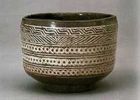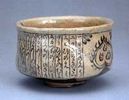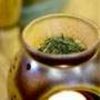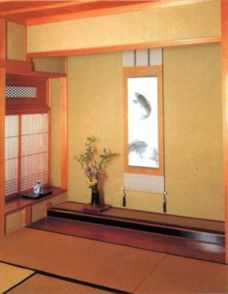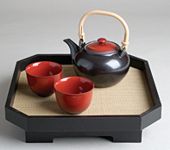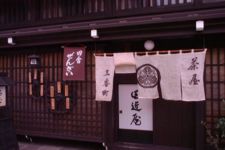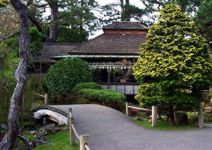|
|
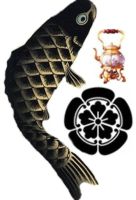 |
![]()
![]()
WHAT'S IN A NAME Map
of Kazusa and Owari.
|
In 1412, a new clan emerged near the edge of Central Japan. His descendants would from then on be called the Lords of Kazusa. The patriarch and first Chief of this clan was TAKEDA NOBUNAGA. His father's name was Takeda Nobumitsu, a relative of Takeda Shingen of Kai. Other Lords from this clan were Takeda Nobukatsu, Takeda Nobuyasu, Takeda Nobutaka and Takeda Nobumasa. Unfortunately they slumbered back to oblivion after getting defeated by the Satomi clan -- although the clansmen themselves still survived in 16th century. Kazusa would by then become a slice of Oda Nobunaga's territory, and among the appelations that Oda got was as Commander of this domain. By the way, 'nobunaga' is a lexical construxion made of 'grand/great/faith/bliss' ('nobu') and 'lasting/long' ('naga'). While the clan's name, Oda, means 'great field'. |
| Just in passing, here is a list of the meanings of Japanese names that you would find all over this site (ingredients of the column at your right are clickable): | |||||
|
|
|
|||
|
_bata _take Fujiwara Fukuzawa Hayashi Honda Ii Ikeda Ishida Ishikawa Iwamura Kawakami Kuroda Kurosawa Maeda Matsumoto Minamoto Miyamoto Miyazaki _mizu Mori Murasaki _nada Takenaka Nakamura Nijo Okazaki Okita Omura Oyama Sakamoto Shimada Shirakawa Suzuki Takeda Tanizaki Tsukiyama Ueda uji_ Takauji Yamazaki Hideyoshi Yoshimura Akihito Akira Atsumori _bei Daigo Daisuke _emon Shingen Kenshin Hajime Mitsuharu Hideaki Takashi Takeshi Hikaru Hiko Shishio Makoto Hirohito Hiroyuki ie_ Kaoru Katsu_ Kitsuno Kiyomasa Kiyomori Kiyonaga Kobayakawa Koichi Kusunoki Megumi Mitsuhide Motonari Mutsuhito Nagamasa Nobutaka Ryu Sukemori Terumoto Toranaga Toshiie Tsunayoshi Ieyasu Yoshiaki Yoshinaka Yoshinobu Akiko Amako Azumi Chihiro Junko Koyuki Masako Midori Motoharu Nakagawa |
field (as in 'corn') peak (as in 'mountain) wisteria of the swamp deep creek woods prominent rice field house field by the pond stony field stony river rock village river gods black field black creek front field pine town original town shrine town shrine point (as in 'knife') water forest violet (color) gulf inside of bamboo inner village second avenue great point (as in 'cliff') great north great village great mountain town on the slope island field white river tree of bells warrior field point of a valley moon of the mountain upper field clan clan of gentlemen summit (of a mountain) the good sun good village the autumn man clear/clarity the kind woods peace great man big help guard new sword new sword the beginning bright spring (season) the autumn sun gentleman brave the shining one bright the lion king loyalty generous man heavy snowfall house perfume-like victory plain orange (color) pure truth clear forest great purity small swift stream first kid camphor tree kind and generous beauty the bright sun becoming the basis a man from Mutsu province lasting truth great hawk style (in swordsplay) keeper of the woods the shining origin lasting tiger house of genius good rope house of peace good autumn good inside-out good and great autumn kid kid nun beautiful and kind generous relative truthful kid lady snowfall child of truth green (color) town of spring (season) in the river |
||||
| HOW
DO JAPANESE PEOPLE NAME THEMSELVES? WHAT ARE THE JAPANESE TITLES, JOBS, AND WORDS THAT HAVE BEEN WRONGLY TAKEN AS NAMES BY NON-JAPANESE PEOPLE? CLICK HERE |
![]()
The utterly nonsensical habit of having tea ceremonies (I'm speaking for you here) had been a sensible item among the hordes of rigid rituals routinely infected the periods in Japanese history since the Heian era (click here for story & pictures of it), but it got suddenly transformed into a major diversion in the midst of the 'Warring States Period' of 16th century. It's funny that even historians are still asking why so. Exactly because the age was so overwhelmingly turbulent, a few minutes out of this world -- which was a tea-related thing was all about -- became all the rage. It was perfectly illogical but (and) absolutely punctual like the meltdown of Windows operating system in 21st century. But, while Windows incite suicides and nervous-breakdown among the frustrated customers who nonetheless insist on using it instead of other systems, tea ceremony in Oda Nobunaga's days served an entirely opposite function: it kept sanity in place -- though of course it wouldn't work for those who never had one to begin with, so we shouldn't wonder why some warlords stayed as insane as ever even after their thousandth tea-ceremony. And Oda Nobunaga was the one who made tea-related stuff -- and all sorts of the usually impractical visual arts -- functional in the realm of feudal politicking since 1568. It started from his meeting with a merchant of Sakai, a very famous one, Imai Sokyu (Imai was one of the few people whom Oda Nobunaga saw before he died in 1582 -- click here for story and pictures). The city of Sakai was virtually owned and operated by people like Imai. As merchants occupied the lowest plane on the Japanese feudal pyramid (click here for story & pictures), they tried to exert some authoritative chirp when Oda wanted the city to get under his control, since the merchants knew they got what Oda wanted -- import biz, etc. Imai managed to talked his colleagues into submission. And he managed to cancel Oda Nobunaga's attack on the city, by having his friend Tsuda Sokyu to host a tea party for Oda Nobunaga and his Generals -- legend says there were 100 of the Oda men present at this colossal event. And in the middle of this back-breaking ceremony, Imai gave (in all the due ceremonial reverence) a tea set to Oda, which was named 'Matsushima' (that's a style) -- like the one pictured at your right side now. So Imai triggered Oda Nobunaga's passion for collecting tea sets, something that he would be having until his last day on earth. When this was known by the rest of Japan, people started to take it as a symbol of surrender or submittance under Oda Nobunaga's overlordship when giving him such gifts. It was not just tea sets, but also paintings and other trinkets, because Oda Nobunaga was kind of like my Grandma -- they both never discarded anything. The surviving members of the warrior-monks sent a lot of classic Buddhist (Chinese) paintings to Azuchi as a token of submission after the Hiei mountains battle of 1571 (click here for story and pictures). But not everyone was okay with that kind of politix. Matsunaga Hisahide (click here for profile and pictures) created sensation when he said to his men, "I'd rather take my tea set to hell with me than giving it to Oda Nobunaga!" and smashed the dear old tea set on the wall, minutes before Oda's soldiers crushed Matsunaga's last defense and he died in 1577. So because Oda Nobunaga wanted everybody's tea sets, those everybody suddenly couldn't part with the tea sets no matter what. It would have been a very laughable confusion of vindictive motives and collectors' desires and possessive instincts, if only it was not so gory. Oda Nobunaga established the handing off of tea utensils as a grant to seal alliance and reward for services, regardless of whether the persons involved were interested in collecting such items or would they have much preferred some cash. He started it by giving (not giving back, as symbolism of the era stated) the 'Matsushima' tea set to Tsuda Sogyu when Sakai had proven to be a good vassal city while between the merchants and the Oda clan had been some mutually-beneficial biz. After Oda's death, as a symbol of acknowledging Toyotomi Hideyoshi as Oda's successor, Tsuda gave the same tea set to him. Still the same old tea set was given to Tsuda by Toyotomi when Sakai had been his good vassal city for years. Then Tsuda gave it to Shogun Tokugawa Iemitsu (click here for story and pictures). And true to the Tokugawa DNA that boldly contained something ordinary mortals called 'talent to be misers', no one ever heard of the tea set being given to anybody else after that. Oda Nobunaga was, no matter how crazy he could be in collecting trinkets, just personally eccentric. But Toyotomi was always an extravagant wowmaker. Imitating Oda's hobby in this tea-related stuff, and continuing Oda's teacup diplomacy, he hit upon ideas such as the colossal tea party at Kitano forest to which he invited 6,000 people or so. He made the title 'tea master' to embody a rather disproportional authority compared to what it was about. Since the remaining Oda kids were clawing each other's throats for being the chief of the clan (click here for story and pictures), Toyotomi could get much of Oda Nobunaga's collexion for free and in large packages at once from Oda Nobunaga's lamentable son Oda Nobuo (click here) since 1583. Tokugawa Ieyasu (click here) -- who had also been imitating Oda Nobunaga's hobby around tea, especially interesting to him I bet because it never involved his money at all -- sent some tea items to Toyotomi after the Oda succession war was over -- as a gesture of acknowledgement of Toyotomi's legitimacy as Oda's successor. Starting this year, Toyotomi's major biz when not planning and doing wars was to show off his collexion to the 'public' -- highest-ranked vassals, allies, and rather tamed enemies. His first famous show was held at Yamazaki in 1583 when he showed Oda Nobunaga's favorite collexion -- such as a jar known as 'Pine Flower' and tea set named 'Ocean Clouds' -- and told the audience (as well as giving them all the needed visual clues) that he still maintained Oda Nobunaga's place as his late master and mentor. This gesture sufficiently impressed the Sakai merchants and tea masters who at least a bit doubted Toyotomi's worth in 'civilized' arts because of his total lack of noble pedigree. Toyotomi didn't have much time (and Oda had even less) to learn about tea-related stuff when Oda was still around, but now he tapped everything he could download from Lord Hosokawa Fujitaka (click here for profile and pictures). Hosokawa, a true-blue nobleperson (his clan had been Ashikaga shogunate's advisors since a hundred years back or so), was the most 'civilian' General and warlord around, and he knew all of such things as tea ceremonies. Oda Nobunaga let him stick around after banishing Shogun Ashikaga Yoshiaki in 1568 precisely because of Hosokawa's civilian hobbies in which he excelled. |
Oda Nobunaga was a fan of tea-related stuff and a collector of tea utensils, not any inch close to being one of the so-called 'tea-masters'. It was his younger brother Oda Nagamasu (1548-1622) that made tea-related biz a full-time occupation. To Nobunaga, it was just a hobby.
Oda
Nobunaga's 'Matsushima'
Tokugawa tea cup, 1600's
Japanese always prefer green tea
A tea party in Oda's times involved all this
A middle-class private tea room in Gifu
A 21st century tea set
Still in the years of 1583-1585 Toyotomi Hideyoshi came to learn from Oda Nobunaga's younger brother that would outlive everyone, Oda Nagamasu -- who would be known in the shrouded little world of tea-fans as Master Yuraku ('Yurakusai-sensei' in Japanese; click here). Nagamasu had never been too busy whacking people's heads off like his late brother, so he had time to attain perfection in this art that he would get immortalized by. Tea saved him from Tokugawa Ieyasu's 'cleansing' program, too; it was too barbaric for Tokugawa's own taste to eradicate this 'civilian' remain of Oda Nobunaga's DNA-sharer. |
|
Teahouse
in Gifu, said to have been in biz |
Tokugawa
period (1600-1868) |
Meiji
period (1868-1912) teahouse |
| Click here for BIG PICTURES of Japanese traditional tea houses. | ||
| HAVE YOU EVER SEEN ANY PICTURE OF..... | Oda Nobunaga's BIRTH? |
| Oda NOBUHIDE (Nobunaga's father)? | Oda Nobunaga's WEDDING? |
| The GUNS that Oda Nobunaga's FACTORY produced? | Oda Nobunaga NAKED? |
| Oda Nobunaga supervising CONSTRUXION workers? | Oda Nobunaga's LETTERS? |
| Statue of Oda Nobunaga's HORSE? | The Oda Nobunaga ROSE? |
| Oda Nobunaga's CONCUBINES? | Oda Nobunaga's INVENTION? |
| Click here for complete story & pictures of the real-life Oda Nobunaga's FASHION statements | |
|
|
|
|


